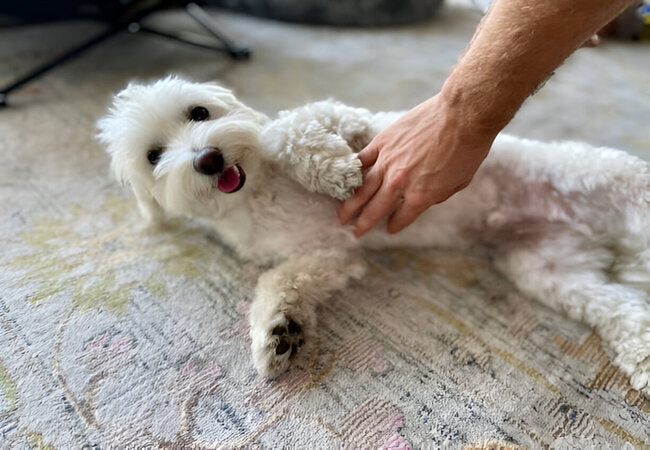Why Dogs Love Belly Rubs in 2025 – Vet‑Reviewed Science & Tips 🐶💆

In this article
Why Dogs Love Belly Rubs in 2025 – Vet‑Reviewed Science & Tips 🐶💆
By Dr. Duncan Houston BVSc
There’s nothing quite as heartwarming as your dog rolling onto their back, paws in the air—inviting a belly rub. But beyond the cute moment lies fascinating canine science. In this 2025 vet-informed guide, we explore why dogs adore belly rubs, how they show consent, and how to bond safely and joyfully through this intimate interaction. Let’s dive into the paws and cause! 🐾
1. The Feel-Good Hormone Release
When you rub your dog’s belly, they often release oxytocin (“love hormone”) and endorphins—creating physical comfort and emotional closeness. Studies demonstrate increased oxytocin and lowered cortisol after gentle interaction.
2. A Trust Signal & Bond Reinforcer
Exposing the belly—a vulnerable area—is a profound sign of trust. Dogs aren't born to expose their underside for attention unless they feel completely safe. This invitation also echoes social grooming behaviors seen in wild canines—strengthening bonds through gentle human touch.
3. Bodies Greet You with Scratch Reflex
That rhythmic leg-kicking? It's an involuntary scratch reflex triggered by nerve sensors on the belly—similar to your knee-jerk when tapped. Most dogs find it oddly satisfying, helping them scratch itches beyond their reach.
4. Cool Comfort & Grooming Sensation
With thinner fur, the belly gives enhanced tactile feedback during a rub. Dogs may also enjoy the cooling effect on a warm day—or recall the gentle grooming maternal licks from puppyhood.
5. Subtle Communication: Consent & Context
Not every dog loves belly rubs—body language tells us a lot. A happy belly rub looks like loose posture, a wagging tail, soft eyes, and relaxed mouth. Conversely, stiff body, tucked tails, lip licking, or tucked heads signal discomfort or appeasement, not invitation.
6. Safe & Effective Belly Rub Techniques
- Always let your dog roll onto their back—don’t force the posture.
- Start with gentle stroking, pausing every few seconds to watch reaction.
- Use open palm and circular strokes, avoiding the nipples and genitals.
- Stop immediately if the dog stiffens, moves, or shows calming signals.
- Match your pressure to your dog’s comfort—some like light strokes, others deeper massage.
7. Why Some Dogs Hate Belly Rubs
Certain dogs—often protective or less social—may view belly exposure as a threat. Dominant breeds or guard-trained dogs might perceive this as invasive. Respect their boundaries and opt for chest, shoulder, or neck pets instead.
8. Moments Belly Rubs Are Especially Good
Great times for belly rubs include:
- After a calming moment together, e.g., after a walk or cuddle session.
- To comfort during low-stress transitions or after mild anxiety.
- In training partnership—using it as a positive reward after good behavior.
🐶 When to Skip Belly Rubs
- If your dog shows fear, memory of trauma, or medical issues in their abdomen.
- If your dog avoids touch in general, they may have underlying pain or sensitivity—consider vet consultation.
- During high-arousal moments where belly rubs could accidentally reinforce frustration-driven behaviors.
9. The Scratch Reflex: What It Tells Us
The hind-leg kick during a belly rub is the scratch reflex—a neural response evolved to combat pests. While you rub, the belly's sensitive spots stimulate spinal reflexes. Dogs often retain this reflex long after puppyhood, and it’s benign.
10. Strengthening the Human–Dog Bond
Belly rubs release oxytocin in both parties, building trust and emotional connection. When delivered with consent and attention, they become powerful touchpoints in your relationship.
👌 Tips for Responsible Belly Rubs
- Always wait for your dog to invite (roll over).
- Monitor punctuation: rub 5–10 seconds, pause, check for signals.
- Adapt based on dog preference—gentle strokes or circular massage as they like.
- Learn your dog’s unique comfort cues and always respect them.
- Offer rubs in calm, low-stress settings to reinforce relaxation.
📋 Quick Reference Table
| Reason | Signs of Enjoyment | Strategy |
|---|---|---|
| Oxytocin + pleasure | Wiggly, soft posture, tail wag | Rub gently, pause often |
| Scratch reflex | Leg-kicking | Enjoy it—it’s natural |
| Trust signal | Relaxed, airy, open belly | Bond and praise calmly |
| Avoids belly rubs | Tension, lip lick, withdrawal | Respect boundary, try other spots |
| Possible pain | Avoids touch persistently | Consult vet |
📱 Ask A Vet App 2025 Support
With the Ask A Vet app you can:
- Send videos to confirm if belly rubs feel good or mask discomfort.
- Get guidance on pressure and technique suited to your dog's body type and health.
- Receive tailored training to build consent and comfort through positive touch.
Your dog’s belly rub moments are precious—expert help keeps them happy and safe. 🐾📲
❤️ Final Thoughts
Belly rubs are more than a sweet gesture—they’re intimate, stress-reducing, bonding experiences grounded in science and canine trust. In 2025, we recognize their value, but also the importance of consent and body language. Keep it gentle, watch your dog’s signals, and enjoy that perfect connection moment.
Need personalized advice? Visit AskAVet.com or download the Ask A Vet app for on-demand support about touch, behavior, or health.






